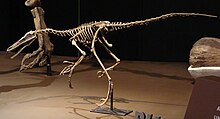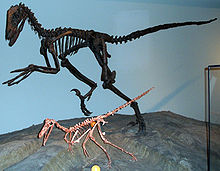Buitreraptor
| Buitreraptor Temporal range: Late Cretaceous,
| |
|---|---|

| |
| Royal Ontario Museum, Toronto, Canada | |
| Scientific classification | |
| Domain: | Eukaryota |
| Kingdom: | Animalia |
| Phylum: | Chordata |
| Clade: | Dinosauria |
| Clade: | Saurischia |
| Clade: | Theropoda |
| Family: | †Dromaeosauridae |
| Subfamily: | †Unenlagiinae |
| Genus: | †Buitreraptor Makovicky, Apesteguía & Agnolin, 2005 |
| Species: | †B. gonzalezorum
|
| Binomial name | |
| †Buitreraptor gonzalezorum Makovicky, Apesteguía & Agnolin, 2005
| |
Buitreraptor is a predatory dromaeosaurid theropod dinosaur from the Cretaceous of Argentina.
Buitreraptor was described in 2005. The type species is Buitreraptor gonzalezorum. It was rooster-sized and had a very elongated head with many small teeth.
Description

Buitreraptor was a rather small dinosaur. In 2010, Gregory S. Paul estimated the length at 1.5 metres, the weight at three kilograms.[1]
Buitreraptor has some different physical features than typical northern dromaeosaurs, such as Velociraptor.
Buitreraptor has a slender, flat, extremely elongated snout with many small teeth that lack meat-tearing serrations or cutting edges and are grooved, strongly recurved and flattened.[2][3] From this, the scientists who initially described it concluded that this dinosaur was not a hunter of relatively large animals like some other dromaeosaurs, but rather a hunter of small animals such as lizards and mammals. The forelimbs of Buitreraptor were long and ending in hands with three fingers. The fingers were proportionarly shorter than in other dromaeosaurids, and of essentially the same length, contrary to most of its relatives, which had fingers of different length, with the second finger being considerably longer.
The body as a whole was also very elongated, with a shallow ribcage. The sickle claw at the second toe of the foot was relatively short and broad.
No fossil discoveries have been made of any feathers of Buitreraptor. However, there are relatives like Microraptor and Sinornithosaurus, of which fossils with preserved feathers are known. Since its close relatives had feathers, it is likely that Buitreraptor also was feathered. According to Apesteguia, this is comparable to reconstructing an extinct monkey with fur because all modern monkeys have fur.[4]
Discovery and naming

Four skeletons of Buitreraptor were found in 2004 in sandstone in Patagonia, Argentina during an excavation led by Sebastián Apesteguia, researcher of CONICET at the Fundacion Felix de Azara - Maimonides University, and Peter Makovicky, curator of dinosaurs at the Field Museum in Chicago.
Buitreraptor is from the early Late Cretaceous Candeleros Formation, dating to the Cenomanian-Turonian, about 94 million years ago, when South America was an isolated continent like Australia today. It was uncovered in a famous fossil site named La Buitrera, the "vulture roost". Although dinosaurs are rare in this site, another nearby site had earlier yielded Giganotosaurus, one of the largest known carnivorous dinosaurs.[5]

Buitreraptor gonzalezorum is the only known species of the genus Buitreraptor. It was named by Macovicky, Apesteguía and Federico Agnolín. The genus name means "vulture raider", from the Spanish word buitre meaning vulture, in reference to La Buitrera, and Latin raptor, "seizer". The specific name honours the brethren Fábian and Jorge González who realised much of the actual excavation and preparation of the fossils.[5]
The holotype specimen, MPCA 245, consists of a partial skeleton with skull of an adult individual. The paratype is MPCA 238, a sacrum with a right pelvis and right hindlimb.[5] The two other specimens have remained undescribed.
Classification

Buitreraptor shows a mosaic of dromaeosaurid, troodontid and avialan traits. It was in 2005 assigned to the Dromaeosauridae. A cladistic analysis by the describers showed it was part of the dromaeosaurid Unenlagiinae.
The discovery of Buitreraptor has also been the subject of discussion among scientists as to the question whether flight could have evolved independently in birds and dromaeosaurids or was derived from some flying common ancestor.[6] Some scientists propose that Rahonavis, a relative to Buitreraptor, could fly. However, evidence for flight has not been unequivocally found in other dromaeosaurids, which has led some scientists to propose that dromaeosaurids evolved flight independently of birds if Rahonavis could indeed fly.
The following cladogram is based on the phylogenetic analysis conducted by Turner, Makovicky and Norell in 2012, showing the relationships of Buitreraptor among the other genera assigned to the taxon Unenlagiinae:
| Unenlagiinae |
| ||||||||||||
Evolution

Other than Buitreraptor, the only other known dromaeosaurs from the southern continents are Neuquenraptor, Austroraptor, and Unenlagia from South America (discovered earlier in 2005), Rahonavis (once thought to be a true avian bird) from Madagascar, and unidentified dromaeosaur-like teeth from Australia. This discovery in the Southern Hemisphere helped scientists to clarify that the dromaeosaur family was more widely dispersed around the world than previously thought. Evidence indicates that dromaeosaurs first appeared during the Jurassic Period, when all the continents were much closer together than they are today. With the discovery of Buitreraptor, the scientists proposed that dromaeosaurids originated somewhere around 180 million years ago, before Pangaea broke up.[5][7] However, other paleontologists have in later studies placed the time of origin for dromaeosauridae to about 160 million years ago.[8]
The scientists see it as an alternative possibility that dromaeosaurids originated on the ancient continent Laurasia in the north and during the Cretaceous Period migrated to southern Gondwana, since the species known from the Southern Hemisphere bear distinctive characteristics not shared by their northern relatives. La Buitrera also yielded remains of terrestrial crocodiles, pterosaurs, the largest known rhynchocephalians, limbed snakes, iguanian lizards, chelid turtles, mammals, and dipnoan fishes [5]
See also
References
- ^ Paul, G.S., 2010, The Princeton Field Guide to Dinosaurs, Princeton University Press p. 139
- ^ Gianechini, F.A.; Apesteguía, S.; Makovicky, P.J (2009). "The unusual dentiton of Buitreraptor gonzalezorum (Theropoda: Dromaeosauridae), from Patagonia, Argentina: new insights on the unenlagine teeth". Ameghiniana. 46 (4): 29R.
- ^ Gianechini, F.A.; Makovicky, P.J; Apesteguía, S. (2011). "The teeth of the unenlagiine theropod Buitreraptor from the Cretaceous of Patagonia, Argentina, and the unusual dentition of the Gondwanan dromaeosaurids". Acta Palaeontologica Polonica. 56 (2): 279–290. doi:10.4202/app.2009.0127.
- ^ National Geographic: "New Birdlike Dino Adds to Debate on Origins of Flight", 18-10-2005.
- ^ a b c d e Makovicky, Peter J.; Apesteguía, Sebastián; Agnolín, Federico L. (2005). "The earliest dromaeosaurid theropod from South America". Nature. 437: 1007–1011. Bibcode:2005Natur.437.1007M. doi:10.1038/nature03996. PMID 16222297.
- ^ New Scientist: "Feathered flight, so good they did it twice?", 15-10-2005.
- ^ EurekAlert!: "Newly discovered birdlike dinosaur is oldest raptor ever found in South America: Relative of Velociraptor rewrites evolutionary charts", 12-10-2005.
- ^ Hu, D.; Hou, L.; Zhang, L.; Xu, X. (2009), "A pre-Archaeopteryx troodontid theropod from China with long feathers on the metatarsus", Nature, 461 (7264): 640–643, Bibcode:2009Natur.461..640H, doi:10.1038/nature08322, PMID 19794491
{{citation}}: Unknown parameter|lastauthoramp=ignored (|name-list-style=suggested) (help)
External links
- BBC News: Bird-like dinosaur forces rethink, 13-Oct-2005
- Drawing and some details from the Natural History Museum, London.
- National Science Foundation web site


